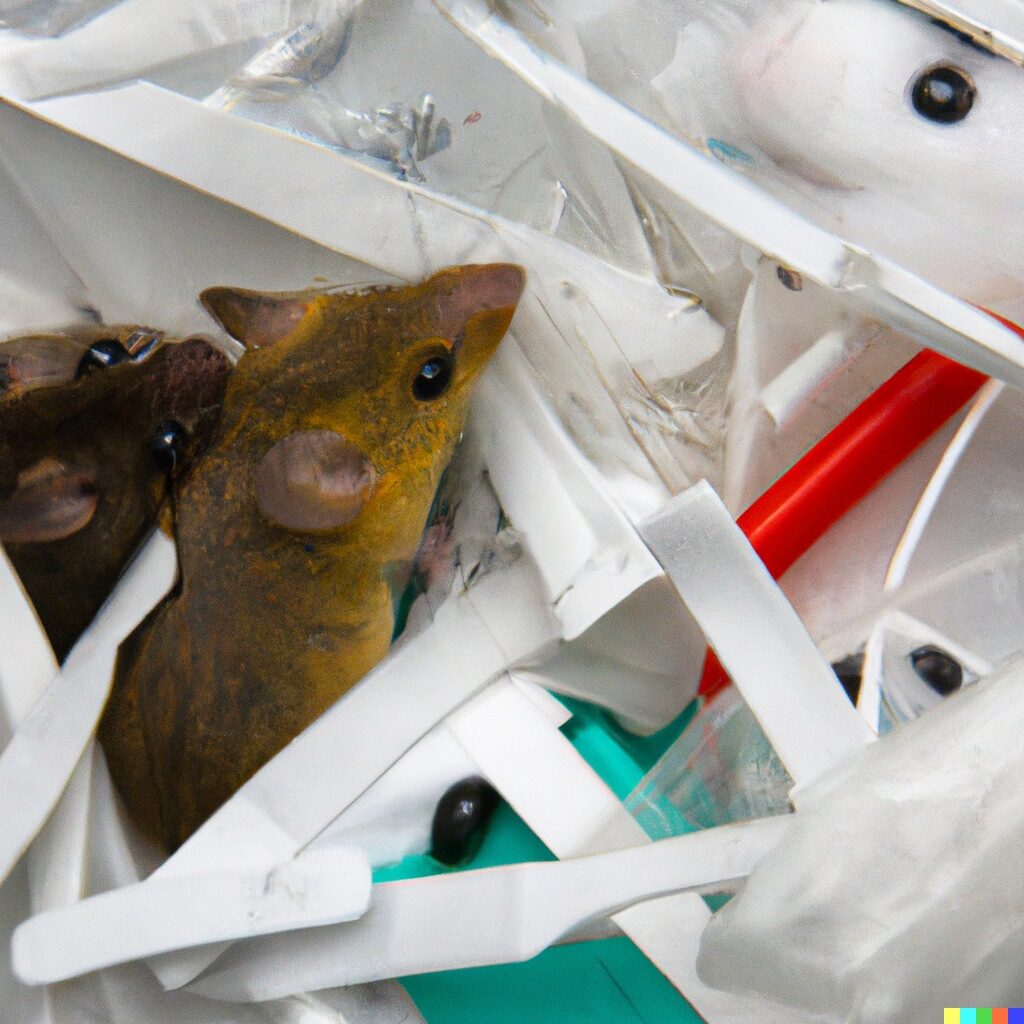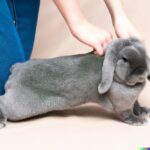Have you ever seen a mouse nibbling on plastic? It may seem odd, but the answer to this question is surprisingly complex. While mice have been observed eating plastic in some cases, it’s important to understand that doing so can be dangerous for their health. Now let’s find out what you need to know before feeding your pet mouse plastic, as well as why you shouldn’t do that.
What Causes Mice to Eat Plastic?
Mice and other rodents have been observed consuming plastic items, but why? The truth is that the exact cause of this behavior is unknown; while there are a few theories as to what could be causing it, none have been proven. Have you ever wondered if mice eat wood?
One common idea is that mice might eat plastic because they think it’s food. Mice typically feed on small seeds or grains, and the texture of some plastics can resemble these foods. In addition, many types of plastic contain small amounts of oil or grease residue from their manufacturing process, which could also attract mice to them due to their smell. Another possible explanation is that certain additives used in the production of plastics can make them taste sweet and appealing to mice.
It’s important to note that eating plastic isn’t just a problem for mice; animals such as birds, fish, marine mammals, rabbits, and even dogs have all been found with pieces of discarded plastic in their stomachs. To keep this problem from getting worse, we need to keep looking into possible causes and solutions. This will help us protect the environment for future generations.
Potential Dangers of Eating Plastic for Mice
Eating plastic can be a major health risk for animals, especially mice. Mice are especially at risk of getting sick from eating plastic because they are so small. It is estimated that up to 70% of the world’s mouse population has eaten some form of plastic in their lifetime. This is an alarming statistic and calls for greater awareness around this issue.
There are many things that could go wrong if you eat plastic, from physical damage to your organs, like blockages and long-term inflammation, to chemical poisoning from chemicals like bisphenol A (BPA). If a blockage keeps food from moving through the digestive tract properly, it can cause malnutrition or even death. Chronic inflammation can cause long-term damage in areas like the liver or kidneys, leading to organ failure and death. BPA is known to mess up hormones in mammals, which over time could lead to problems with reproduction or other serious health problems. Also, microplastics have been found in the stomachs of mice, which may increase the amount of chemicals that get into their bodies because chemicals in these tiny particles can leak out.
It is very important that we all do what we can to use less single-use plastics so that we don’t keep putting wildlife in danger. We should also encourage others around us to do what they can too, so we can reduce our collective impact on wildlife populations, including those of mice, which are particularly susceptible due to their small size when compared with other animals.
- Reduce single use plastics.
- Encourage others around you.
Other Reasons Why Mice May Try to Chew On Plastic
Mice chewing on plastic is a common problem for many homeowners, but why do mice have this urge? It could be due to the fact that they are curious and attracted to shiny new items. They may also be trying to satisfy their natural instinctive desire for something difficult to chew. Finally, some experts believe it may even be an evolutionary adaptation from when these animals were living in the wild and needed materials like plastic for shelter or insulation.
Exploring New Things
The first reason why mice might gnaw on plastic could simply be because they’re looking for something new and interesting to explore. Mice get bored just like humans do, so given the opportunity, they will often investigate unfamiliar objects such as electrical wires or pieces of plastic that can be found around homes. As mammals with strong senses of smell and sight, they can find potential food sources or places to nest just by looking. This makes them more likely than other rodents to check out anything that looks interesting.
- Piqued interest in exploring unfamiliar things
- Highly developed senses used to find potential food sources
Chewing Instincts
Furthermore, mice have strong instincts that tell them what kinds of objects to chew on in order to keep their teeth healthy and sharpened over time (just like we brush our teeth)! But if a mouse can’t find wood or cardboard in its immediate environment, it may start chewing on plastic as a “chew toy” substitute to satisfy its instinctual need to chew.
- “Chew toy” substitutes used if no wood/cardboard present
- “Natural instinct” tells them what types of objects should be chewed upon
How can you reduce the risk of your pet mouse eating plastic?
The risks associated with pet mice ingesting plastic are significant. It could kill them and cause you and your pet mouse a lot of trouble. As such, taking steps to reduce the risk of this happening should be a top priority if you have a pet mouse in your home.
Firstly, when buying toys or accessories for your pet mouse’s enclosure, make sure they are made from safe materials that won’t break apart easily into small pieces that could potentially get eaten by your beloved rodent companion. Before putting something into the environment, it’s also a good idea to check it carefully to make sure it doesn’t have any sharp edges or broken parts that could be dangerous. Also, don’t use anything with glue or other strong adhesives, because these things may contain toxins that could hurt your pet if it ate them.
Second, check your pet’s home often for signs of damage or wear and tear so that you can get rid of anything dangerous right away.
- Check all bedding material thoroughly and replace any damaged pieces
- Ensure food bowls and water bottles remain securely attached
- Check walls and floors for chew marks
Finally, monitor precisely what goes in (and out) of the cage, including supervising playtime, so you know exactly where everything is at all times! This will help minimize potential risks posed by stray objects such as coins or buttons that may have been left lying around inside the enclosure. By following these simple precautions you should greatly reduce any chances of danger coming to your precious little one through ingestion of foreign objects
Alternatives To Feeding Your Pet Mouse Plastic
Wheels
When it comes to caring for a pet mouse, the plastic wheel often becomes synonymous with the animal. But that doesn’t have to be the case! There are plenty of alternatives available when it comes to providing a way for your pet mouse to get its daily exercise.
Paper Towel Rolls Cut up paper towel rolls into small sections and place them around your cage or tank. Your mouse will enjoy playing in these as they can chew on them and go through them like tunnels or hidey-holes. Plus, this is an inexpensive and easy DIY solution!
Cardboard boxes Cardboard boxes come in all shapes and sizes—from shoeboxes to large shipping boxes—and can provide hours of entertainment for your pet mouse. They love exploring new objects, so give them some fun cardboard items such as tubes, cubes, or even houses that you can make out of old cereal boxes. Just make sure there are no sharp edges that could harm their tiny feet!
FAQS
Do mice eat paper?
No, mice typically do not eat paper. They are omnivores and prefer to feed on insects, fruits, vegetables, and grains. They will also sometimes consume small amounts of meat or other animal products. Paper is not a natural food source for them, so they tend to avoid it as much as possible.
What material can mice not chew through?
Mice are known for being able to chew through almost anything, but there are a few things they can’t get through. Steel wool, caulk, steel mesh, and silicon caulking are all too tough for mice to chew through. Also, things like metal flashing and sheet metal can make an impenetrable barrier against these annoying animals.
What scent will keep mice away?
Mice are notoriously sensitive to certain smells, so one of the easiest and most natural ways to keep them away is with strong scents like peppermint, cayenne pepper, garlic, or ammonia. These fragrances confuse and irritate mice, making your home less attractive to them. You can also buy rodent repellents from the store. They have the same smells in a more concentrated form.
Should I remove the plastic under my mouse?
It’s a good idea to remove the plastic from under your mouse if it is getting in the way of you using it. Doing this will help make sure that the plastic won’t get in the way of how well and accurately you can use your mouse. However, make sure that removing it won’t damage or interfere with any other parts of your setup before attempting this.
Why do mice chew plastic pipes?
Mice often chew on plastic pipes because it is a way for them to sharpen their teeth, which naturally grow continuously. Also, some rodents may be drawn to the smell and taste of the plastic as they explore new areas. Mice who are trying to get rid of boredom or stress can also use these things to chew on.
How do you scare mice away?
Mice can be scared away by using natural or synthetic repellents. Natural options include peppermint oil, ammonia, and cayenne pepper-based sprays. Ultrasonic devices that send out sound waves to drive mice out of their hiding places are examples of man-made solutions. They won’t be able to get into your home in the first place if you fill any cracks with steel wool and caulk them.
What can I spray to keep mice away?
There are a few ways to keep mice away. You can spray an essential oil such as peppermint, which is unpleasant for mice but not harmful to humans. You could also use a commercial rodent repellent like capsaicin or naphthalene, which are made from natural or synthetic ingredients. Whichever method you choose, it’s important to understand the potential risks and follow the instructions carefully when spraying around your home.










